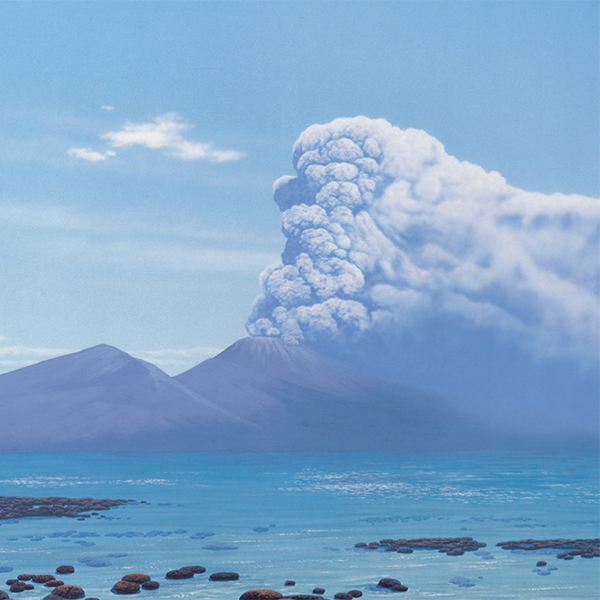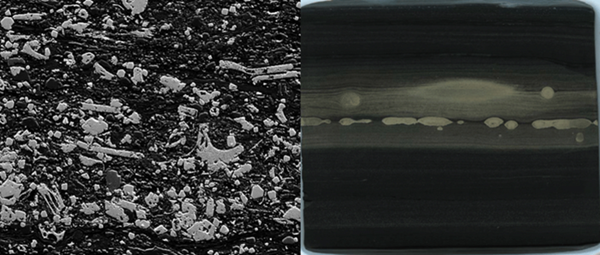Evidence arguing for a "whiff of oxygen" before the Earth's Great Oxygenation Event 2.3 billion years ago are chemical signatures that were probably introduced at a much later time, according to research published in Science Advances.

The result rewinds previous research findings that atmospheric oxygen existed prior to the so-called Great Oxygenation Event–known to researchers as "GOE"– and has the potential to rewrite what is known of the planet's past. And without the whiff of oxygen reported by a series of earlier studies, the scientific community needs to critically re-evaluate its understanding of the first half of Earth's history.
The study indicates that the chemical data originally determined to suggest atmospheric oxygen earlier in Earth's history may have been introduced by events hundreds of millions of years later. Additional analysis conducted as part of the study reconfirms that Earth's atmosphere featured exceedingly low oxygen levels prior to 2.3 billion years ago.
The research team used new tools to investigate the origins of the signals of trace oxygen and found that a series of changes after the sediments were deposited on the seafloor were likely responsible for the chemical evidence of oxygen.
For decades, scientists had debated when measurable levels of oxygen first appeared in Earth's atmosphere. The idea of the Great Oxygenation Event had developed over the last century and is thought to be when oxygen levels began to increase over 2 billion years ago, paving the way for the rise of complex cells, animals, and eventually humans.
More recently, however, research on chemical signals correlated to oxygen has suggested earlier transient appearances of oxygen, known as "whiffs."
In 2007, two parallel studies found evidence of such a whiff of oxygen based on samples of the 2.5-billion-year-old Mount McRae Shale, part of a heavily studied 2004 drill core collected in Western Australia by the NASA Astrobiology Drilling Program.
The 2007 studies were based on evidence of oxidation and reduction of molybdenum and sulfur, two elements that are widely used to test for the presence of atmospheric oxygen since it cannot be measured directly in rock. The findings raised fundamental questions about the early evolution of life on Earth.
The observation of early oxygen was taken by some research groups to support earlier findings that microscopic cyanobacteria—early innovators in photosynthesis—pumped oxygen into the ancient atmosphere, but that other Earth processes kept oxygen levels low.
The 2007 studies, including their implications about the origin of life and its evolution, have been widely accepted and have served as the basis for a series of other research papers over the last 14 years.
The new study dates back to 2009 when a Caltech-led team began efforts to conduct additional analysis. The team, some of whom have since moved to other institutions, took over a decade to collect and analyse data, resulting now in the first published study that directly refutes the finding of a whiff of early oxygen.
The 2007 research papers that found the whiff of oxygen prior to Earth's full oxygenation used bulk analysis techniques featuring geochemical assessments of powdered samples sourced from throughout Mount McRae Shale. Rather than conducting a chemical analysis on powder, the new research inspected specimens of the rock using a series of high-resolution techniques.
For the new study, the research team recorded images of the 2004 drill core on a flatbed optical scanner. Based on those observations, they then collected thin samples for additional analyses. The suite of approaches used on the physical specimens, including synchrotron-based X-ray fluorescence spectroscopy, gave the team additional insight into the geology and chemistry of the samples as well as the relative timing of processes that were identified.

The new analysis shows that Mount McRae Shale is formed from organic carbon and volcanic dust. The research indicates that molybdenum came from volcanoes and subsequently concentrated during what has been previously characterized as the whiff interval. During a series of chemical and physical changes that turned these sediments into rock, fracturing created pathways for several distinct fluids to carry in signals of oxidation hundreds of millions of years after the rocks formed.
If the molybdenum was not from oxygen-based weathering of rocks on land and concentration in the ocean, its presence does not support the original finding of early atmospheric oxygen. By using a totally different methodology than that used in the first studies that found a whiff of oxygen, the new research also calls into question research that followed from those studies using the same style of bulk techniques.
In addition to providing an alternate explanation for oxygen proxies that were found in the Mount McRae Shale, the team confirmed that the level of atmospheric oxygen at the time before the Great Oxygenation Event was very low, calling it "negligible" in the approximate period of 150 million years before the abrupt change.
The findings call into question the early existence of cyanobacteria, instead of supporting other hypotheses that oxygen-generating photosynthesis evolved only shortly before the Great Oxygenation Event.
---
EDITOR: This text was adapted from the Joint Press Release by Dartmouth College and the Earth-Life Science Institute (ELSI) https://www.eurekalert.org/news-releases/939025
| Journal | Science Advances |
| Tile of the paper | Reexamination of 2.5-Ga “whiff” of oxygen interval points to anoxic ocean before GOE |
| Authors |
Sarah P. Slotznick1*, Jena E. Johnson2, Birger Rasmussen3,4, Timothy D. Raub5,6, Samuel M. Webb7, Jian-Wei Zi4, Joseph L. Kirschvink8,9, Woodward W. Fischer8 |
| Affiliations | 1. Department of Earth Sciences, Dartmouth College, Hanover, NH 03755, USA. 2. Department of Earth and Environmental Sciences, University of Michigan, Ann Arbor, MI 48103, USA. 3. School of Earth Sciences, The University of Western Australia, Perth, WA 6009, Australia. 4. State Key Laboratory of Geological Processes and Mineral Resources, China University of Geosciences, Wuhan, Hubei 430074, China. 5. School of Earth and Environmental Sciences, University of St Andrews, St Andrews, Fife, KY16 9AL, Scotland, UK. 6. Geoheritage Research Institute, Arlington Heights, IL 60005, USA. 7. Stanford Synchrotron Radiation Lightsource, Stanford University, Menlo Park, CA 94025, USA. 8. Division of Geological and Planetary Sciences, California Institute of Technology, Pasadena, CA 91125, USA. 9. Earth-Life Science Institute, Tokyo Institute of Technology, Tokyo 152-8550, Japan. |
| DOI | 10.1126/sciadv.abj7190 |
| Online published date | 5 January 2022 |
